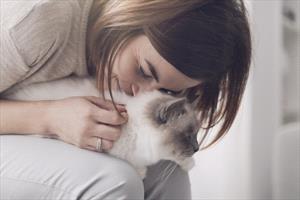Cat hugged on lap

Photo courtesy of Depositphoto
Several years ago we were between cats, our last one having died a few months prior. My family was ready to get new ones, so we visited our local shelter to select two new family members. One of the cats we interviewed was a handsome young adult. He readily purred and rolled over for petting, showing a very lovable side. After a few days of introducing him to our home and the other cat we adopted, it became evident he was a biter. (I should have suspected such since the purported reason for him being turned in by his previous owner was Allergic to Cats. I've worked in shelters. I know that while this can be true, some people surrendering cats won't divulge the real reason and use allergies as an excuse for the relinquishment.)
Over several months of working with him, his sweet side won out and the biting behavior stopped. Given that he always inhibited his bite, never breaking skin, and that the circumstances provoking him to bite were predictable, I strongly suspect his first family who had had him since he was a kitten didn't know how to behave with cats. I suspect they inadvertently taught him to bite.
Like puppies and toddlers, biting cats are rarely trying to be mean. They are trying to communicate in the only way they can. It is us humans who tend to fail in this department. We don't “listen” when a cat tries to tell us how she's feeling. For instance, if a cat isn't in the mood to be petted, then when we restrain her for petting anyway, we aren't listening. A cat that tries to leave while being petted and isn't allowed to go must resort to other tactics. A cat that bites has likely given indicators that she was annoyed and a bite was coming. Those signs can include a hard stare, a rapidly twitching tail, an attempt to move away, or a growl. To the cat, biting is a way of saying, “Why aren't you listening to me? I've already told you to leave me alone.” It's not unlike a human who starts with a polite request and ends with screaming. If one volume and tone won't work, then it's time to get louder and more direct. And the more often a cat has to resort to biting to be understood, the faster she will resort to that response in subsequent interactions.
Many people make the mistake of inadvertently teaching their cats to be aggressive, then they wonder why it's happening. Rough play is a common cause, especially one using human body parts such as hands or feet as toys. In a kitten, it may seem cute, but it definitely won't be in an adult cat. When petting your kitten or cat, if he starts to become more excited by rougher handling and play, stop! You are teaching him to be aggressive towards humans. Instead, return to gentle, calm petting or use toys for initiating play. These can be ones that you control like a wand toy you hold, or ones that sit someplace for your kitty to interact with when he wants to. They can be small toys or larger ones like cat trees. Even an empty paper bag or cardboard box makes a good toy for many cats. (Given that we're all getting so much shipped to us right now, I know you've got some great boxes lying around the house just waiting for the cat to jump in.)
Cats can also be taught to exhibit desirable behaviors, and these can be used to distract them from undesirable ones. One such desirable behavior may be to come when called. If you train your cat to do that, then you can call her away from undesirable behavior and give her a nice reward when she comes. For instance, imagine she's on a high shelf. You don't want her there, but you also know that if you try to pick her up to move her, she may scratch or bite. Instead of picking her up, call her over, and then reward her with a treat when she comes. By rewarding desirable behavior, anticipating problems before they occur, and ignoring undesirable behavior or redirecting it to something better, you can develop a happier relationship with your kitty.